This is a list of flags of different designs that have been used in Australia.
National flags
| Flag | Date | Use | Description |
|---|---|---|---|
.svg.png.webp) |
1901–1903 | Historic flag, original 1901 Federal Flag Design Competition winner | A Blue Ensign defaced with the six-point Commonwealth Star in the lower hoist quarter and the five stars of the Southern Cross in the fly half (each star had a varying number of points: 9, 8, 7, 6 and 5—with Alpha Crucis being larger than Beta and Gamma and with Delta being smaller than Beta and Gamma[1]). It was first flown in Melbourne on 3 September 1901. That day is known as Flag Day. |
.svg.png.webp) |
1903–1908 | Historic national flag as approved by King Edward VII | A Blue Ensign defaced with the six-point Commonwealth Star in the lower hoist quarter and the five stars of the Southern Cross in the fly half (all stars had seven points, except the smallest star only had 5 points). |
.svg.png.webp) |
1908–present | Australian National Flag, naval jack and state ensign | A Blue Ensign defaced with the seven-point Commonwealth Star in the lower hoist quarter and the five stars of the Southern Cross in the fly half. |
 |
1908–present | Vertical flag of Australia |
Other flags recognised under the Flags Act 1953
| Flag | Date | Use | Description |
|---|---|---|---|
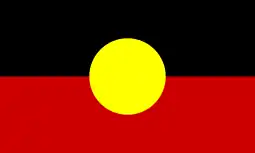 |
1971–present | Australian Aboriginal Flag | A black and red flag with a yellow circle in the middle. The flag was designed in 1971 by Harold Thomas. |
| Link to file | 1992–present | Torres Strait Islander Flag | A five-pointed star and traditional headdress in white, on a blue, green and black background. It was designed in 1992 by Bernard Namok. |
Personal flags
Sovereign
| Flag | Date | Use | Description |
|---|---|---|---|
.svg.png.webp) |
1962–2022 | Personal Australian Flag of Queen Elizabeth II | Consists of a banner of the coat of arms of Australia, defaced with a gold seven-pointed federation star with a blue disc containing the letter E below a crown, surrounded by a garland of golden roses. |
Governor-General
| Flag | Date | Use | Description |
|---|---|---|---|
.svg.png.webp) |
1902–1909 | Flag of the governor-general of Australia | A Union Flag defaced with a six pointed star, crowned, surrounded by ears of corn and a gold circlet. The crown used is the Tudor Crown. |
.svg.png.webp) |
1909–1936 | Flag of the governor-general of Australia | A Union Flag defaced with a seven pointed star, crowned, surrounded by ears of corn and a gold circlet. The crown used is the Tudor Crown. |
.svg.png.webp) |
1936–1953 | Flag of the governor-general of Australia | A crowned lion standing on a crown on a blue field. The crown used is the Tudor Crown. |
 |
1953–present | Flag of the governor-general of Australia | A crowned lion standing on a crown on a blue field. The crown used is St Edward's Crown. |
State governors
| Flag | Date | Use | Description |
|---|---|---|---|
 |
1981–present | Flag of the governor of New South Wales | The state flag with a crowned badge. |
 |
1876–present[lower-alpha 1] | Flag of the governor of Queensland | The Union Flag defaced with the state badge. |
 |
1975–present | Flag of the governor of South Australia | The state flag with a crowned badge. |
 |
1977–present | Flag of the governor of Tasmania | The state flag with a crowned badge. |
 |
1984–present | Flag of the governor of Victoria | The state flag with a yellow field and crowned southern cross. |
 |
1988–present | Flag of the governor of Western Australia | The state flag with a crowned badge. |
Prime Minister
| Flag | Date | Use | Description |
|---|---|---|---|
.svg.png.webp) |
1950s–1966 | Old car flag of the prime minister of Australia | The Australian national flag defaced with the coat of arms of Australia placed between the Commonwealth Star and the Southern Cross. Used by Robert Menzies in the 1950s and 1960s.[4][5][6] |
Coronation Standards
| Flag | Date | Use | Description |
|---|---|---|---|
.svg.png.webp) |
1911 | Old Coronation Standard | Banner of arms of Australia |
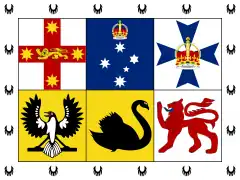 |
1937 and 1953 | Coronation Standard | Banner of arms of Australia |
Civil ensigns
| Flag | Date | Use | Description |
|---|---|---|---|
.svg.png.webp) |
1901–1903 | Red version of the 1901 Federal Flag Design Competition winner | A Red Ensign defaced with the six-point Commonwealth Star in the lower hoist quarter and the five stars of the Southern Cross in the fly half (each star had a varying number of points: 9, 8, 7, 6 and 5—with Alpha Crucis being larger than Beta and Gamma and with Delta being smaller than Beta and Gamma[7]). |
.svg.png.webp) |
1903–1909 | Old Red Ensign, first version approved by King Edward VII | A Red Ensign defaced with the six-point Commonwealth Star in the lower hoist quarter and the five stars of the Southern Cross in the fly half (all stars had seven points, except the smallest star only had 5 points). |
 |
1909–present | Australian Red Ensign | A Red Ensign defaced with the seven-point Commonwealth Star in the lower hoist quarter and the five stars of the Southern Cross in the fly half. |
.svg.png.webp) |
1935–1948 | Old Australian Civil Air Ensign | Based on the British Civil Air Ensign, with the addition of the Southern Cross and Commonwealth Star in yellow. |
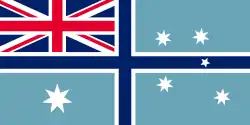 |
1948–present | Australian Civil Air Ensign | Based on the British Civil Air Ensign, with the addition of the Southern Cross and Commonwealth Star in white. |
Australian Defence Force
| Flag | Date | Use | Description |
|---|---|---|---|
| Link to file | 2000–present | Australian Defence Force Ensign | A tricolour of dark blue (navy); red (army) and light blue (airforce) with the Triservice badge. |
Royal Australian Navy
| Flag | Date | Use | Description |
|---|---|---|---|
 |
1911–1967 | Royal Australian Navy Ensign | British White Ensign.
It was replaced by the Australian White Ensign. |
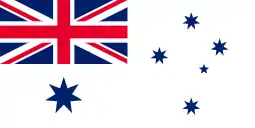 |
1967–present | Australian White Ensign | A version of the national flag with a white field defaced with a blue Commonwealth Star in the lower canton quarter and a blue Southern Cross in the fly. |
 |
1920–present | Flag of the Chief of Navy | A fouled anchor on a red-blue background. |
 |
1956–1972 | Sea Cadet Corps | A British Blue Ensign with the badge of the Sea Cadet Corps in the fly. Replaced by the Naval Reserve Cadets Ensign. |
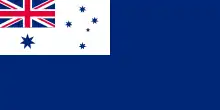 |
1972–2001 | Naval Reserve Cadets Ensign | A British Blue Ensign with the Australian White Ensign in canton and the badge of the Naval Reserve Cadets in the fly. Replaced by the Australian Navy Cadets Ensign. |
| Link to file | 2001–present | Australian Navy Cadets Ensign | A British Blue Ensign with the Australian White Ensign in canton and the badge of the Australian Navy Cadets in the fly. |
 |
1983–Present | Queen's Colour for the Royal Australian Navy (1983-2022) King's Colour for the Royal Australian Navy (2022-Present) |
Royal Australian Air Force
| Flag | Date | Use | Description |
|---|---|---|---|
 |
1921–1948 | Royal Australian Air Force Ensign | British Royal Air Force Ensign. |
.svg.png.webp) |
1948–1982 | Royal Australian Air Force Ensign | The national flag with a light blue field, the Southern Cross tilted and the RAAF roundel placed in the lower fly. |
 |
1982–present | Royal Australian Air Force Ensign | The national flag with a light blue field, the Southern Cross tilted and the RAAF roundel (Kangaroo) placed in the lower fly. |
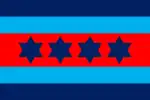 |
1982–present | Flag of the Australian Air Chief Marshal | Five horizontal stripes of dark blue, light blue, red, light blue and dark blue, four six-pointed stars in the middle stripe. |
Australian Border Force
The department names of Australia's border protection service have slightly changed over time, they are as follows;
- Department of Trade and Customs (1 January 1901 – 1956)
- Department of Customs and Excise (1956–1975)
- Department of Police and Customs (1975–1975)
- Department of Business and Consumer Affairs (1975–1982)
- Department of Industry and Commerce (1982–1984)
- Department of Industry, Technology and Commerce (1984–1985)
- Australian Customs Service (1985–2009)
- Australian Customs and Border Protection Service (2009–2015)
- Australian Border Force (2015–present)
| Flag | Date | Use | Description |
|---|---|---|---|
.svg.png.webp) |
1832–1882 | New South Wales Customs Flag | |
 |
1882-1901 | New South Wales Customs Flag | |
 |
1949-1952 | Customs Flag of the Territory of Papua and New Guinea | |
 |
1901–1903 | Australian Customs Flag | The Australian national flag defaced with "HMC AUSTRALIA" |
 |
1903–1904 | Australian Customs Flag | The Australian national flag defaced with "HMC AUSTRALIA" |
 |
1904–1909 | Australian Customs Flag | The Australian national flag defaced with "HMC" |
 |
1909–1988 | Australian Customs Flag | The Australian national flag defaced with "HMC" |
 |
1988–2015 | Australian Customs Flag | The Australian national flag defaced with "CUSTOMS" |
 |
2015 | Australian Border Force Flag as used temporarily | The Australian national flag defaced with "BORDER FORCE" |
 |
2015–present | Australian Border Force Flag | The Australian national flag defaced with "AUSTRALIAN BORDER FORCE" |
Federal and state police
| Flag | Date | Use | Description |
|---|---|---|---|
| Link to file | 1982–present | Flag of the Australian Federal Police | A black-white-black vertical tricolor, with the badge of the Australian Federal Police in the centre of the white stripe. A black-and-white checkerboard borders the flag. |
| Link to file | 1981–present | Flag of the New South Wales Police Force | An azure-and-white horizontal bicolor with the badge of the New South Wales Police Force in the centre of the flag. |
| Link to file | 2006–present | Flag of the Northern Territory Police | A variant of the Northern Territory flag with the Northern Territory Police badge replacing the flower in the fly. |
| Link to file | 2006–present | Flag of the Queensland Police Service | A light blue-and-dark blue horizontal bicolor with the badge of the Queensland Police Service in the centre of the flag. |
| Link to file | 1993–present | Flag of the South Australia Police | A British Blue Ensign defaced with the badge of the South Australia Police within a white disk. |
 |
??–present | Flag of the Tasmania Police | An azure flag with the badge of the Tasmania Police in the centre of the flag. |
| Link to file | ??–present | Flag of the Victoria Police | A British Blue Ensign defaced with the badge of the Victoria Police. |
| Link to file | 2005–present | Flag of the Western Australia Police | A white flag with a stylised depiction of a swan and checkerboard in blue, with the Western Australia Police emblem added. |
Commonwealth Lighthouse Service
| Flag | Date | Use | Description |
|---|---|---|---|
 |
Lighthouse Service Flag (Government Ship) | Flag of Australia Inside the Southern Cross is a lighthouse service badge. | |
 |
Lighthouse Service Flag (Private Boat) | Civil ensigns, at the bottom of the flag is the lighthouse service badge. |
Emergency Services and Health Care flags
| Flag | Date | Organisation | Description |
|---|---|---|---|
 |
1984–present | New South Wales Ambulance | |
| Link to file | Fire and Rescue New South Wales | ||
| Link to file | New South Wales Rural Fire Service | ||
 |
New South Wales State Emergency Service | ||
 |
Victoria State Emergency Service | ||
 |
1959–present | Royal Flying Doctor Service of Australia | Replaced in general use in 1993 due to a rebranding, the flag however isn't considered obsolete as its still used for official engagements. |
 |
1978–present | Western Australia Fire and Rescue Service | |
Sporting flags
| Flag | Date | Use | Description |
|---|---|---|---|
 |
1908–1912 | Flag of the Australasian Olympic Team | A Blue Ensign defaced by a white circle containing the British Crown plus a shield containing the Southern Cross. |
| Link to file | 1983–present | Boxing Kangaroo sporting flag | A golden kangaroo wearing red boxing gloves on a green field. |
| 2000 | Sydney Olympics sporting flag | [8] | |
| 2006 | Melbourne Commonwealth Games sporting flag | [8] |
Vexillology Association flags
| Flag | Date | Use | Description |
|---|---|---|---|
 |
Flag of the Flag Society of Australia Inc. | ||
States and territories
States
| Flag | Date | Use | Description |
|---|---|---|---|
 |
1876–present | Flag of New South Wales | A St George's Cross with four gold stars and a lion in the fly of a British blue ensign. |
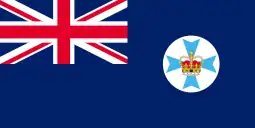 |
1876–present[lower-alpha 1] | Flag of Queensland | A light blue Maltese cross with a crown on a white background in the fly of a British blue ensign. |
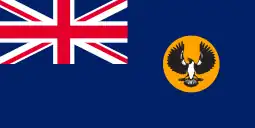 |
1904–present | Flag of South Australia | A piping shrike on a gold background in the fly of a British blue ensign. |
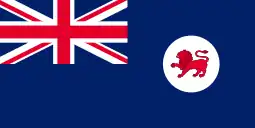 |
1876–present | Flag of Tasmania | A red lion on a white background in the fly of a British blue ensign. |
.svg.png.webp) |
1877–present[lower-alpha 1] | Flag of Victoria | The Southern Cross surmounted by a crown in the fly of a British blue ensign. |
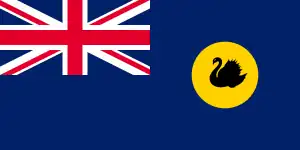 |
1953–present | Flag of Western Australia | A black swan on a gold background in the fly of a British blue ensign. |
Historical
| Flag | Date | Use | Description |
|---|---|---|---|
.svg.png.webp) |
1867 | Flag of New South Wales | |
.svg.png.webp) |
1870–1876 | Flag of New South Wales | |
.svg.png.webp) |
1859 | Flag of Queensland | |
.svg.png.webp) |
1870–1876 | Flag of Queensland | |
.svg.png.webp) |
1876–1901 | Flag of Queensland | |
.svg.png.webp) |
1901–1963 | Flag of Queensland | |
.svg.png.webp) |
1870–1876 | Flag of South Australia | |
.svg.png.webp) |
1876–1904 | Flag of South Australia | |
.svg.png.webp) |
1875 | Flag of Tasmania | |
.svg.png.webp) |
1870-1877 | Flag of Victoria | |
.svg.png.webp) |
1877 | Flag of Victoria | |
.svg.png.webp) |
1877–1901 | Flag of Victoria | |
.svg.png.webp) |
1901–1952 | Flag of Victoria | |
.svg.png.webp) |
1870–1953 | Flag of Western Australia |
Internal territories
| Flag | Date | Use | Description |
|---|---|---|---|
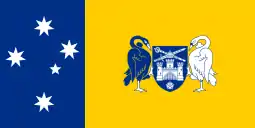 |
1993–present | Flag of the Australian Capital Territory | One third blue with the Southern Cross, the other two thirds are yellow with the coat of arms of Canberra. |
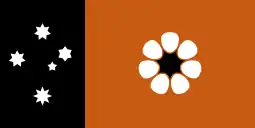 |
1978–present | Flag of the Northern Territory | One third black with the Southern Cross, the other two thirds are Ochre with Sturt's Desert Rose, the floral emblem of the Territory. |
External territories
| Flag | Date | Use | Description |
|---|---|---|---|
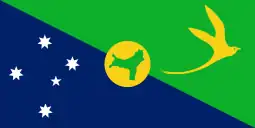 |
2002–present | Flag of Christmas Island | The blue and green diagonal panels represent the sea and the island's vegetation, a small map of the island is included in the centre. The main emblem is a golden bosun bird. The flag was selected from a competition held in 1986 and was approved in 2002. |
_Islands.svg.png.webp) |
2004–present | Flag of the Cocos (Keeling) Islands | The flag is green, with a palm tree on a gold disc in the canton, a gold crescent for the Cocos Malay people in the centre of the flag and a gold southern cross in the fly. The flag was designed in 2003 becoming official in 2004. |
 |
1980–present | Flag of Norfolk Island | A green field with a white square containing a green Norfolk Island pine. |
Historical
| Flag | Date | Use | Description |
|---|---|---|---|
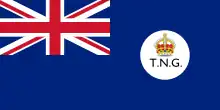 |
1914–1949 | Flag of the Territory of New Guinea | British blue ensign with a white disk on the fly, filled with the Tudor Crown and the initials “T.N.G.” |
 |
1902–1949 | Flag of the Territory of Papua | British blue ensign with a white disk on the fly, filled with the Tudor Crown and the initials “Papua”. |
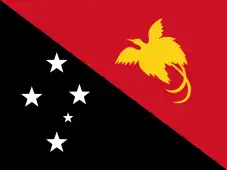 |
1971–1975 | Flag of the Territory of Papua and New Guinea | The upper triangle is red with the soaring Raggiana Bird of Paradise and the lower triangle is black with the Southern Cross of four white larger five-pointed stars and the smaller star. |
Proposed states
| Flag | Date | Party | Description |
|---|---|---|---|
.svg.png.webp) |
2020 | Bob Katter's proposed flag for State of North Queensland | |
.svg.png.webp) |
1980 | Proposed flag for State of North Queensland | Proposed flag designed by Edward Cattoni in 1980, and approved at a meeting of the North Queensland State Party on 16 October 1994.[9][10] |
.svg.png.webp) |
2005 | Ian Johnston's proposed flag for a State of North Queensland | Proposed flag for Capricornia (which has been suggested as an alternate name for a separate North Queensland state).[11] |
.svg.png.webp) |
2005 | Ian Johnston's proposed flag for a New England state | |
Cities and areas
| Flag | Date | Use | Description |
|---|---|---|---|
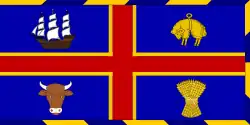 |
1982–present | Armorial Flag of the City of Adelaide | Blue background divided into four quarters by a Saint George's Cross outlined in gold overlain with the Arms of the City of Adelaide. Flag bordered on three sides by diagonal blue and gold stripes.[12] |
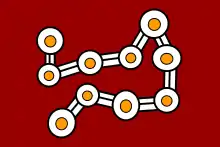 |
Flag of the local government area of Anangu Pitjantjatjara Yankunytjatjara | The logo of Anangu Pitjantjatjara Yankunytjatjara on a red field. | |
 |
1947–present[13] | Flag of the City of Brisbane | Blue background (representing the Brisbane River) bordered by a golden checker pattern (representing the Sun and Brisbane's warm climate) with the flag divided into six quarters. The upper hoist quarter contains a golden caducei superimposed on wavy white lines, representing the Brisbane River and its ties to the city's commerce. The lower hoist quarter contains two Stafford knots and a white star arranged vertically (all represent the achievements in astronomy of Sir Thomas Brisbane, for whom the city is named). The remaining segments alternate between these two designs. The flag design is based on the shield on the coat of arms of Brisbane.[14][15] |
 |
2009–present | Flag of the City of Darwin | According to council policy, Darwin maintains two flags.[16] The policy reads "One flag will contain the official Coat of Arms, with its nine colours and the CITY OF DARWIN printed underneath in blue, on a yellow background flanked by red and green. The other flag will contain the City Logo and be in the colours of blue, green and white, on a white background."[17] |
 |
Flag of the City of Hobart | The flag of Hobart City Council, of Tasmania, Australia. Designed in 1951 by Hobart architect and alderman, I.G. Anderson and first flown in 1953.
The star is derived from the arms of Lord Hobart, 4th Earl of Buckinghamshire (1760–1816), Secretary of State for War and the Colonies at the time of colonial settlement (1804), and after whom Hobart is named. The colour used on the arms Lord Hobart was, in fact, sable (black), rather than blue. The red lion is from the Tasmanian flag – and its location at the top of the shield signifies Hobart's position as the Capital City.[18] | |
 |
Flag of the City of Launceston | The Launceston flag design is based on the city's coat of arms granted by the College of Arms, London, on 11 June 1957.[19] The Brisbane Street Mall, the War memorial at Royal Park, the original Queen Victoria Museum (now the Art Gallery) building, atop the Council Chambers and on top of the Albert Hall are places in the city where the flag is regularly flown. The three intersecting lines in the flag represent the city's three rivers (North Esk, South Esk and Tamar) and the two rectangles in the lines represent tin ingots. The strip across the top with the jagged edge is green to represent the city's parks, gardens and surrounding countryside. Waratah flowers at the top symbolise all flowers and similar beauties of nature. The ingots are included because Launceston used to be a large tin smelting centre. The little circle at the river junction is Launceston. | |
 |
Flag of the City of Melbourne | White background divided into four quarters by a Saint George's Cross outlined by a concise and overlain with St Edward's Crown. Quadrant features represent the main activities of the economy of the City of Melbourne in the mid 19th century and are, in a clockwise direction from top left, a fleece hanging from a red ring (wool), a black bull standing on a hillock (cattle), a three-mast ship in full sail (shipping), and a spouting whale in the sea (whaling). The flag design is identical to the shield on the coat of arms of Melbourne.[20] | |
| 1961–present | Flag of the City of Newcastle | The colours are brown over green, taken from the shoulder patch of a Battalion raised in the Newcastle/Hunter region. The shield has a gold chief, containing a black diamond, a white sheep's fleece banded gold and a black wheel, representing the principal pursuits of the area: coal mining, farming and grazing, and industry and trade. Below this, the field is green, with a blue downward pointed triangle (pile) bordered gold, portraying a port with the waters of the sea thrusting into the green land. Fertility is emphasised by the gold border. The crest is a lighthouse, for the Nobby's Head lighthouse at the entrance to the harbour, and sits on a helmet with mural crown (city status) and blue, green and gold mantling. The arms stand on a compartment depicting the golden sand and white waves of the city's beaches (with a scroll inscribed "Enterprise") and are supported by two seagulls with mural crowns (the setting and nature of the city).[21] | |
 |
1949–present | Flag of the City of Perth | Saint George's Cross overlaid with the City of Perth coat of arms in the centre.[22] |
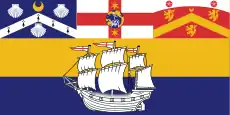 |
1908–present | Flag of the City of Sydney | The flag is a horizontal triband of three colours – white, gold and blue. The top third features three designs. In the top left the arms belong to Thomas Townshend, Viscount Sydney, after whom the city was named. The English Naval Flag in the centre acknowledges the role Arthur Philip played in Sydney's foundation. The red cross is overlaid with a globe and two stars – the principal features of James Cook's Arms, which were granted as a posthumous honour for his service in mapping Australia. The arms in the top right belong to the first Lord Mayor of Sydney, Thomas Hughes. It was during his term of office that the title of Mayor became Lord Mayor, and the official coat of arms for the city was granted. The remaining field of the flag features a ship under full sail, an allusion to the prominence of Sydney as a maritime port.[23] |
| circa 1960–2008 | Flag of the City of Toowoomba | The flag of Toowoomba city is a violet coloured ensign which makes reference to the city's floral emblem of the day, the Toowoomba Violet (aka the sweet violet, Lat. 'Viola odorata').[24]
Notable is the city's coat of arms[25] in the centre of the ensign and the city's name on the left of the flag, lettered from top to bottom.[26] | |
| 2008–present | Flag of Toowoomba | A new Toowoomba flag was created in 2007 and became the official flag of the Toowoomba Region on 15 March 2008 with the amalgamation of 8 councils; The councils were Clifton Shire, Crows Nest Shire, Cambooya Shire, Jondaryan Shire, Millmerran Shire, Pittsworth Shire, Rosalie Shire and Toowoomba City.[27]
The predominant colours are white and teal. The three white rings in the flag intersect to create eight spaces from their loops and exterior, symbolising the unity of the eight amalgamated former councils. The colour of teal also represents unity.[28] | |
| Link to file | 1965–present | Flag of Wagga Wagga | Officially, the Wagga Wagga City Flag is square.[29] The upper quarter of the flag contains eight stalks of wheat positioned so as to form two capital letters W on a vert (green) field. The lower quarter of the upper half of the flag contains a wavy blue line on gold (yellow) representing the river winding through the wheat fields. The lower half of the flag contains the head of a ram positioned centrally on a vert (green) field. |
.svg.png.webp) |
1850–present | Upper Murray River Flag | Flown by vessels on the upper reaches of the Murray River, predominantly in Victoria. The blue bars are said to represent the four major rivers that form the Murray-Darling River system and their dark hue represents the darker colour of the Murray River's darker waters in Victoria and NSW. |
.svg.png.webp) |
1850–present | Lower Murray River Flag | Flown by vessels on the lower reaches of the Murray River, predominantly in South Australia. The blue bars are said to represent the four major rivers that form the Murray-Darling River system and their light hue represents the lighter colour of the Murray River's lighter waters in South Australia. |
 |
1998–present | Flag of Lord Howe Island, New South Wales | Despite being an unofficial flag of a state-integrated island, it is used to represent the island. |
Political flags
| Flag | Date | Party | Description |
|---|---|---|---|
 |
2020s–present | Communist Party of Australia (1971) | |
 |
2020–present | National Socialist Network (NSN) | One of two flags used. |
 |
1940s–1950s | Communist Party of Australia (1920) | De facto flag seen on photos. |
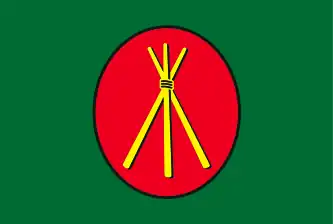 |
1990s–present | Eco Warriors Flag | |
| Link to file | 2016–present | Antipodean Resistance | |
| Link to file | 1996–present | Progressive Labour Party | |
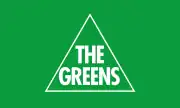 |
1992–present | Australian Greens | |
 |
1960s | New England New State Movement | |
 |
Anarchist-Communist Eureka Flag | ||
 |
Green Eureka flag used by environmental protestors against coal seam gas exploitation. |
Religious flags
| Flag | Date | Use | Description |
|---|---|---|---|
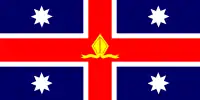 |
Flag of the Anglican Church of Australia | A red St. George's Cross bordered in white, on a field of dark blue, with four white eight pointed stars in each of the four quarters. In the centre is a gold bishop's mitre. | |
 |
Flag of the Grand Orange Lodge of Australia | An orange ensign with the Australian flag in the canton and an open book surmounted by a Saint Edward's Crown in the lower fly. | |
 |
Flag of the Loyal Orange Institution of Victoria | An orange ensign with a Saint George's Cross in the canton, and a Southern Cross with a Saint Edward's Cross above it and an open book below it in the fly. |
Ethnic groups flags
Indigenous
| Flag | Date | Use | Description |
|---|---|---|---|
 |
2011–present | Flag of Adnyamathanha[30] | |
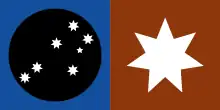 |
?–present | Flag of Aṉangu | |
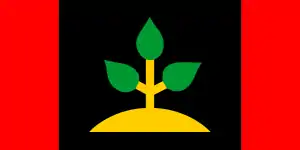 |
1972–present | Flag of the Larrakia people[31] | |
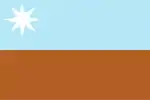 |
2013–present | Flag of Muruwari[32] | |
.svg.png.webp) |
1980s–present | Flag of Meriam – Murray Island[33] | The flag of Murray Island is made of three vertical stripes, red-white-black. In canton, a brown leaf is placed in a white disk. Eight white six-pointed stars surround the disk. |
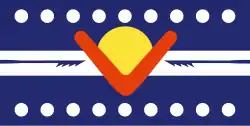 |
1999–present | Flag of Ngarrindjeri[34] | |
 |
2001–present | Flag of Saibai Island[35] | |
| Link to file | 1995–present | Flag of Tunuvivi[36] | |
| 2021–present | Flag of Taungurung | A rectangle diagonally divided by a yellow wavy line. (Heraldic) The right side is ocher with the 7 stars arranged into the constellation of the Pleiades, the left side is black.[37] |
Immigrants
| Flag | Date | Use | Description |
|---|---|---|---|
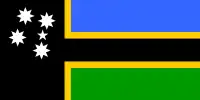 |
1998–present | Flag of South Sea Islanders[38][39] | |
Historical flags
| Flag | Date | Use | Description |
|---|---|---|---|
.svg.png.webp) |
1788–1801 | Union Flag | The Union Flag of the Kingdom of Great Britain. Raised by Captain Arthur Phillip RN on 26 January 1788 at Sydney Cove upon the landing of the First Fleet. |
 |
1801–1903 | Union Flag | The Union Flag of the United Kingdom. |
 |
1806 | Bowman Flag | A white swallow-tail fly, with a crest featuring the Rose of England, the thistle of Scotland and the shamrock of Ireland supported by an emu and kangaroo. The design was an inspiration for Australia's national coat of arms. |
 |
1823/24–1831 | National Colonial Flag for Australia | A British White Ensign, featuring four white stars on the red cross |
 .svg.png.webp) |
1831–1903 (de facto Flag of Australia); 1903–1920s (still commonly used) | Australian Federation Flag/New South Wales Ensign | A British White Ensign, featuring the Cross in Azure with five Argent Stars often varying between 5–8 Points. It was the de facto flag of Australia from 1 January 1901 to 3 September 1901. It was widely used in New South Wales as a local shipping ensign until 1883 when the Admiralty banned its continued use at sea. The Australian government received approval to fly the Blue Ensign in 1903—but the Australian Federation Flag was still commonly unofficially used by members of the populace as late as the 1920s. |
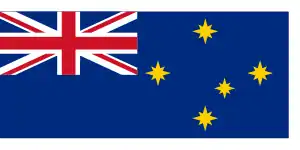 |
1849–1853 | Australasian Anti-Transportation League Flag | British Blue Ensign, with yellow Southern Cross and white border, to which branch names were added |
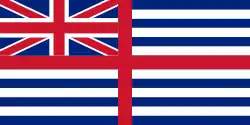 |
1850s–1875 | Van Diemen's Land Ensign | A British White Ensign, featuring six blue bars |
  |
1854 | Eureka Flag | The battle flag of the Eureka Stockade featured the five stars of the constellation Crux Australis in white on a white cross and blue field |
 |
1859 | Queensland Separation Flag | The Queensland Separation Flag, flown on 10 December 1859 to mark Queensland becoming a separate colony from New South Wales. A red cross on a light blue field, with the Union Jack in the canton. |
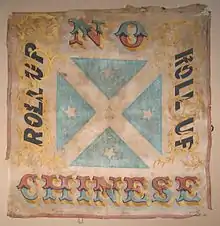   |
1860s | Lambing Flat riots banner, flag and banner flag | Flags associated with the Anti-Chinese Lambing Flat riots. |
.svg.png.webp) |
Post 1910–c. 1945 | British Empire flag | An unofficial flag of the British Empire featuring its constituent dominions and India. The Australian coat of arms are featured in the bottom right. It was flown by civilians as a display of patriotism on special occasions such as Empire Day. The flag was flown at the official unveiling of the Dangarsleigh War Memorial in 1921, and again at the centennial in 2021.[40] |
 |
1918 | Australian Honour Flag | Awarded to towns who exceeded double their quota of war funding. |
| 1988 | Bicentennial Flag | The 200th anniversary of European settlement in Australia[8] | |
| 2001 | Centenary of Federation Flag | The 100th anniversary of Federation – the establishment of the Commonwealth of Australia[8] |
House flags of Australian freight companies
| Flag | Date | Company | Description |
|---|---|---|---|
 |
2012–present | Blue Star Line | |
 |
1991–present | Sydney Ferries | |
 |
1887–1961 | Australasian United Steam Navigation Company | |
 |
1881–1887 | Queensland Steam Shipping Company | |
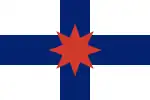 |
1875–2006 | Adelaide Steamship Company | |
 |
1875–1993 | McIlwraith, McEacharn & Co | |
 |
1858–1955 | Illawarra Steam Navigation Company | |
Yacht clubs of Australia
| Flag | Club |
|---|---|
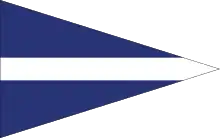 |
Black Rock Yacht Club |
 |
Adelaide University Sailing Club |
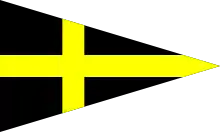 |
Balmain Sailing Club |
 |
Cruising Yacht Club of Australia |
 |
Hamilton Island Yacht Club |
 |
Royal Melbourne Yacht Squadron |
 |
Royal Perth Yacht Club |
.svg.png.webp) |
Royal Yacht Club of Tasmania |
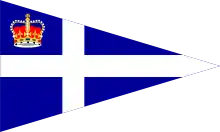 |
Royal Sydney Yacht Squadron |
 |
Sandringham Yacht Club |
 |
Sun City Yacht Club |
 |
Royal Prince Alfred Yacht Club |
 |
Royal Prince Edward Yacht Club |
 |
Royal Queensland Yacht Squadron |
.svg.png.webp) |
Manly Yacht Club |
 |
Little Ship Yacht Club |
 |
Royal Motor Yacht Club of New South Wales |
Other flags/Micronational flags
.svg.png.webp) Flag of the "Dominion of Westralia" as proposed in 1934
Flag of the "Dominion of Westralia" as proposed in 1934
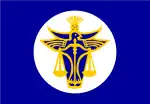
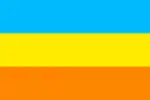


 28 First Nations flags as part of a public art installation at Sydney Airport.
28 First Nations flags as part of a public art installation at Sydney Airport..svg.png.webp) Erroneous flag of Australia (1888)
Erroneous flag of Australia (1888).svg.png.webp) Erroneous flag of South Australia (1908)
Erroneous flag of South Australia (1908).svg.png.webp) Erroneous flag of Victoria (1910)
Erroneous flag of Victoria (1910)
See also
Notes
- 1 2 3 The rendition of the crown has changed according to the monarchs' wishes. In c. 1901 it was changed to the Tudor Crown, and in 1963 to the St Edward's Crown.
References
- ↑ Thomson, Jeff (10 November 2015). "Construction Details of the Australian Flag". FOTW Flags Of The World website. Jon Radel. Retrieved 21 November 2023.
The 1901 Southern Cross star-points ranged from nine (Alpha) to five (Epsilon) and inner diameter of each was 4/9 of their outer diameters. Beta, Gamma and Epsilon were the same outer diameter as today, Alpha was 1/6 and Delta 1/10 of the fly width. In 1903 Alpha, Beta and Delta were altered to the same design as the Gamma Star (1/7 fly width, seven points) thus making the Southern Cross the same as on the current flag.
- ↑ PMC. "Flags Act 1953". www.legislation.gov.au. Retrieved 27 August 2020.
- ↑ Cabinet, Prime Minister and (27 June 2016). "Australian flags". www.pmc.gov.au. Retrieved 27 August 2020.
- ↑ ABC Television show "Auction Room", 11 November 2012
- ↑ Pg 207. Flags of the World, Barraclough, E.M.C., ISBN 978-0-72-322797-7
- ↑ Jonathan Dixon; Ian MacDonald. "Prime Minister – Australia". Retrieved 4 November 2015.
- ↑ Thomson, Jeff (10 November 2015). "Construction Details of the Australian Flag". FOTW Flags Of The World website. Jon Radel. Retrieved 21 November 2023.
The 1901 Southern Cross star-points ranged from nine (Alpha) to five (Epsilon) and inner diameter of each was 4/9 of their outer diameters. Beta, Gamma and Epsilon were the same outer diameter as today, Alpha was 1/6 and Delta 1/10 of the fly width. In 1903 Alpha, Beta and Delta were altered to the same design as the Gamma Star (1/7 fly width, seven points) thus making the Southern Cross the same as on the current flag.
- 1 2 3 4 Historical Flags of Australia
- ↑ Edward Cattoni. "North Queensland State Flag". Retrieved 26 June 2022.
- ↑ Edward Cattoni. "North Queensland State History". Retrieved 26 June 2022.
- ↑ Jonathan Dixon (6 December 2005). "North Queensland State Flag proposals - Capricornia proposal". Flags of the World. Retrieved 27 June 2022.
- ↑ "History of Council". Adelaide City Council. Retrieved 22 January 2015.
- ↑ "The city standard, but do you recognise it?". Brisbane Times. 4 April 2012. Retrieved 22 January 2015.
- ↑ "Symbols used by Council". Brisbane City Council. Retrieved 4 November 2015.
- ↑ Jonathan Dixon; Ian MacDonald. "City of Brisbane (Queensland, Australia)". Retrieved 4 November 2015.
- ↑ "Darwin (Northern Territory, Australia)".
- ↑ "Council's Symbols" (PDF). Archived from the original (PDF) on 25 May 2009. Retrieved 5 December 2016.
- ↑ "Hobart Coat of Arms – City of Hobart, Tasmania Australia". Retrieved 20 September 2018.
- ↑ "Coat of Arms". Launceston City Council. Archived from the original on 22 July 2008. Retrieved 16 August 2008.
- ↑ "Melbourne Day - Melbourne Day". Archived from the original on 25 January 2014. Retrieved 27 May 2014.
- ↑ "City of Newcastle (NSW, Australia)". www.crwflags.com. Retrieved 21 July 2016.
- ↑ "History of the Council". City of Perth. Retrieved 19 December 2013.
- ↑ "Sydney's flag and flower". City of Sydney. Retrieved 26 June 2015.
- ↑ "Arrowhead Voilet". Toowoomba Plants: Natives of the Region suitable for Gardens. 8 September 2011. Retrieved 7 January 2019.
- ↑ "Toowoomba". Heraldy of the World. Retrieved 7 January 2019.
- ↑ "Toowoomba Flags". toowoomba.org. Retrieved 1 January 2019.
- ↑ "Toowoomba Region Amalgamation". Toowoomba Regional Council. Retrieved 1 January 2019.
- ↑ "Toowoomba Flags". toowoomba.org. Retrieved 1 January 2019.
- ↑ "Wagga Wagga City Flag". Retrieved 3 October 2016.
- ↑ "Adnyamathanha (South Australia, Australia)".
- ↑ "Larrakians (Australia)".
- ↑ "Murrawarri Republic (New South Wales-Queensland, Australia)".
- ↑ "Mer (Murray) Island (Australia)".
- ↑ "Ngarrindjeri Nation (Australia)".
- ↑ "Saibai Island (Australia)".
- ↑ "Tiwi Island (Australia)".
- ↑ "Taungurung Sovereign Flag - Taungurung Land & Waters Council". 14 May 2021.
- ↑ "Australian South Sea Islanders flag - ASSI".
- ↑ "Emojis are everywhere, but they can be a painful reminder of exclusion for some". ABC News. 11 May 2019.
- ↑ Ingall, Jennifer (4 June 2021). "Why the Dangarsleigh war memorial flies the Empire flag and what it means to the community". ABC News. Archived from the original on 13 August 2023. Retrieved 13 August 2023.